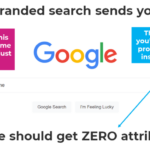Reading Time: 2 min As with most of you, I get hit with cold outreach all the time. Cold emails, phone calls, LinkedIn connections, people at our door, etc. While they may occasionally have decent offers, my rule on cold outreach has become very simple — no. Last week I had someone stop by our house to sell us […]
Marketing
Don’t ascribe attribution to Google when other investments drove the real value
Reading Time: 2 min When monitoring your website traffic, it’s easy to look at your sources and see that Google has sent you the most traffic, leading you to think you should double down on it. Maybe you should, but maybe not. There are certainly people that Google sends to your site that you should be thankful for. If […]
Maximize your interactions
Reading Time: < 1 min Automation in a business, particularly in marketing, is a very attractive thing. You can save time and just have messages and connections happen automatically. With that saved time, you can now do even more! But what “more” will you be doing? In my mind, the messages and connections are the thing you should be doing […]
Does your sign really need a phone number on it?
Reading Time: 2 min Whenever you’re in the car, I’m sure you see many of the same things as you’re driving — signs on the side of the road (or up on billboards) promoting one business or another. Many of them are illegal “bandit signs”, but this isn’t about the legality of them (though I hate those), but more […]
It’s time to confirm your held time
Reading Time: < 1 min This was a new one for me, coming from a company that I trust(ed). I received the email below, and I was kind of surprised. I didn’t remember setting another appointment with them, but perhaps I had forgotten about it. I hadn’t forgotten, but their goal seems to be tricking people into thinking they had. […]
9: What are bad recommendations you hear in your profession?
Reading Time: 2 min On to the 9th questions from “Tribe of Mentors” by Tim Ferriss (see all previous questions here). This one is: What are bad recommendations you hear in your profession or area of expertise? Steven Pressfield believes that going deep is not done often enough: Real work and real satisfaction come from the opposite of what […]
Why doesn’t Coca-Cola advertise their ingredients?
Reading Time: < 1 min Coca-Cola has a “secret recipe”, but you don’t really hear them talk about it much. In fact, you really never hear them talk about any of their ingredients. Why? Consumers don’t really care. In his classic book “Ogilvy on Advertising“, David Ogilvy explains a time when he made this mistake while advertising for a brand […]
You can’t hope for consumer reality
Reading Time: < 1 min A few times on Gary Vaynerchuk’s podcast I’ve heard Gary repeat a very simple phrase: “you can’t hope for consumer reality.“ His push is related to marketing, and particularly to social media. You may be comfortable using Facebook, but if your audience is teens, then Facebook promotions would almost certainly fall flat. You might love […]
One size fits one
Reading Time: < 1 min I’ve talked a few times on here about the Will Guidara’s fantastic book “Unreasonable Hospitality“. On a recent podcast with Rory Vaden, Will took one of the concepts from his book and unpacked it in a way that I found to be very insightful. To understand what he said, you need to know Will’s “Hot […]
Their tricks can work even if you know about them
Reading Time: 2 min The psychology of selling makes me kind of sad. I wish that everyone could just price fairly, explain the product honestly, and we’d go from there. That’s clearly a dream that will never happen, and psychology will always play a part in human-led purchasing decisions. What’s interesting is that psychological tricks can work even if […]









